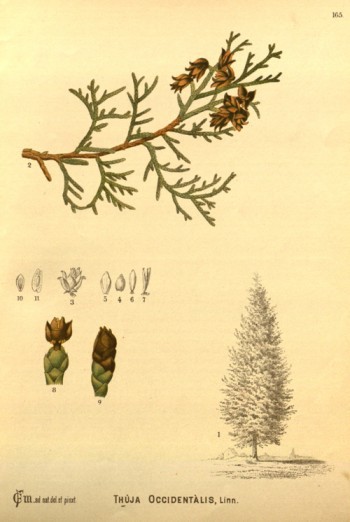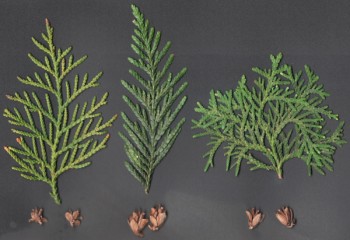
Thuja is a genus of coniferous trees in the Cupressaceae (cypress) family. There are five species in the genus, two native to North America and three native to eastern Asia. The genus is monophyletic and sister to Thujopsis. They are commonly known as arborvitaes (from Latin for tree of life) or Thujas; several species are widely known as cedar but, because they are not true cedars (Cedrus), it has been recommended to call them red-cedars or white-cedars.
Description. Thujas are evergreen trees growing from 10 to 200 feet (3 - 60 m) tall, with stringy-textured reddish-brown bark.
The five species in the genus Thuja are small to large evergreen trees with flattened branchlets. The leaves are arranged in flattened fan shaped groupings with resin-glands, and oppositely grouped in 4 ranks. The mature leaves are different from younger leaves, with those on larger branchlets having sharp, erect, free apices. The leaves on flattened lateral branchlets are crowded into appressed groups and scale-like and the lateral pairs are keeled. With the exception of western red-cedar (Thuja plicata), the lateral leaves are shorter than the facial leaves (Li et al. 2005). The solitary flowers are produced terminally. Pollen cones have 2 to 6 pairs of 2 to 4 pollen sacked sporophylls. Seed cones are ellipsoid, typically 0.36 to 0.55 inch (9 - 14mm) long, they mature and open in their first year. The thin woody cone scales number from 4 to 6 pairs and are persistent and overlapping, with an oblong shape, they are also basifixed. The central 2 to 3 pairs of cone scales are fertile. The seed cones produce 1 to 3 seeds per scale, the seeds are lenticular in shape and equally 2 winged. Seedlings produce 2 cotyledons.
Another very distinct and only distantly related species, formerly treated as Thuja orientalis, is now treated in a genus of its own, as Platycladus orientalis. The closest relatives of Thuja are Thujopsis dolabrata, distinct in its thicker foliage and stouter cones, and Tetraclinis articulata is distinct in its quadrangular foliage (not flattened) and cones with four thick, woody scales.
The genus Thuja, like many other forms of conifers, is represented by ancestral forms in Cretaceous rocks of northern Europe, and with the advance of time is found to migrate from northerly to more southerly regions, until during Pliocene time it disappeared from Europe. Thuja is also known in the Miocene beds of the Dakotas.
The foliage is also readily eaten by deer, and where deer population density is high, can adversely affect the growth of young trees and the establishment of seedlings.
They are widely grown as ornamental trees, and extensively used for hedges. A number of cultivars are grown and used in landscapes. Homeowners will sometimes plant them as privacy trees. The cultivar 'Green Giant' is popular as a very vigorous hedging plant, growing up to 80 cm/year when young.
The wood is light, soft and aromatic. It can be easily split and resists decay. The wood has been used for many applications from making chests that repel moths to shingles. Thuja poles are also often used to make fence posts and rails. The wood of Thuja plicata is commonly used for guitar sound boards.[14] The combination of light weight and resistance to decay has led to Thuja plicata (Western red cedar) being widely used for the construction of bee hives.[citation needed]
Oil of Thuja contains the terpene thujone which has been studied for its GABA receptor antagonistic, with potentially lethal properties.
The natives of Canada used the needles of Thuja occidentalis (Eastern white cedar) to make a tea that has been shown to contain 50 mg of vitamin C per 100 grams; this helped prevent and treat scurvy.
In the 19th century Thuja was commonly used as an externally applied tincture or ointment for the treatment of warts, ringworm and thrush, and a local injection of the tincture was used for treating venereal warts.
